Surface-Oxidised Carbon Nanofibre-Based Nanofluids: Structural, Morphological, Stability and Thermal Properties
Abstract
1. Introduction
2. Experimental Procedures
2.1. Materials
2.2. Surface Oxidation Treatments of CNF
2.3. Characterisation of Surface-Oxidised CNF
2.4. Preparation of Surface-Oxidised CNF-Based Nanofluid
2.5. Physical and Thermal Characterisation of Surface-Oxidised CNF-Based Nanofluid
3. Results and Discussion
3.1. FTIR Spectra Analysis
3.2. Raman Spectroscopy Analysis
3.3. FESEM Analysis
3.4. TGA Results
3.5. Dispersion and Stability Analysis of the Surface-Oxidised CNF-Based Nanofluids
3.6. Thermal Conductivity of the Commercial CNF-Based Nanofluids without PVP
3.7. Effect of PVP on the Thermal Conductivity of the Surface-Oxidised CNF-Based Nanofluids
4. Cost Factor Consideration
5. Conclusions
Author Contributions
Funding
Institutional Review Board Statement
Informed Consent Statement
Data Availability Statement
Acknowledgments
Conflicts of Interest
References
- Gupta, M.; Singh, V.; Kumar, R.; Said, Z. A review on thermophysical properties of nanofluids and heat transfer applications. Renew. Sustain. Energy Rev. 2017, 74, 638–670. [Google Scholar] [CrossRef]
- Norizan, M.N.; Zulaikha, N.D.S.; Norhana, A.B.; Syakir, M.I.; Norli, A. Carbon nanotubes-based sensor for ammonia gas detection—An overview. Polimery 2021, 66, 175–186. [Google Scholar] [CrossRef]
- Zahmatkesh, I.; Sheremet, M.; Yang, L.; Heris, S.Z.; Sharifpur, M.; Meyer, J.P.; Ghalambaz, M.; Wongwises, S.; Jing, D.; Mahian, O. Effect of nanoparticle shape on the performance of thermal systems utilizing nanofluids: A critical review. J. Mol. Liq. 2021, 321, 114430. [Google Scholar] [CrossRef]
- Islam, M.R.; Shabani, B.; Rosengarten, G. Electrical and thermal conductivities of 50/50 water-ethylene glycol based TiO2 nanofluids to be used as coolants in PEM fuel cells. Energy Procedia 2017, 110, 101–108. [Google Scholar] [CrossRef]
- Tawfik, M.M. Experimental studies of nanofluid thermal conductivity enhancement and applications: A review. Renew. Sustain. Energy Rev. 2017, 75, 1239–1253. [Google Scholar] [CrossRef]
- Norizan, M.N.; Moklis, M.H.; Demon, S.Z.N.; Halim, N.A.; Samsuri, A.; Mohamad, I.S.; Knight, V.F.; Abdullah, N. Carbon nanotubes: Functionalisation and their application in chemical sensors. RSC Adv. 2020, 10, 43704–43732. [Google Scholar] [CrossRef]
- Mohamad Saidi, N.; Kasim, N.A.M.; Osman, M.J.; Janudin, N.; Mohamad, I.S.; Abdullah, N. The Influences of Chemical and Mechanical Treatment on the Morphology of Carbon Nanofibers. In Solid State Phenomena; Trans Tech Publications Ltd.: Baech, Switzerland, 2017. [Google Scholar]
- Nagarajan, P.K.; Subramani, J.; Suyambazhahan, S.; Sathyamurthy, R. Nanofluids for solar collector applications: A review. Energy Procedia 2014, 61, 2416–2434. [Google Scholar] [CrossRef]
- Sun, L.; Zhang, X.; Liu, H.; Liu, K.; Du, H.; Kumar, A.; Sharma, G.; Si, C. Recent advances in hydrophobic modification of nanocellulose. Curr. Org. Chem. 2021, 25, 417–436. [Google Scholar]
- Nurazzi, N.M.; Harussani, M.M.; Zulaikha, N.D.S.; Norhana, A.H.; Syakir, M.I.; Norli, A. Composites based on conductive polymer with carbon nanotubes in DMMP gas sensors—An overview. Polimery 2021, 66, 85–97. [Google Scholar] [CrossRef]
- Mohd Nurazzi, N.; Asyraf, M.R.M.; Khalina, A.; Abdullah, N.; Sabaruddin, F.A.; Kamarudin, S.H.; Ahmad, S.; Mahat, A.M.; Lee, C.L.; Aisyah, H.A. Fabrication, functionalization, and application of carbon nanotube-reinforced polymer composite: An overview. Polymers 2021, 13, 1047. [Google Scholar] [CrossRef]
- Nurazzi, N.M.; Abdullah, N.; Demon, S.Z.N.; Halim, N.A.; Azmi, A.F.M.; Knight, V.F.; Mohamad, I.S. The frontiers of functionalized graphene-based nanocomposites as chemical sensors. Nanotechnol. Rev. 2021, 10, 330–369. [Google Scholar] [CrossRef]
- Nayak, L.; Rahaman, M.; Giri, R. Surface modification/functionalization of carbon materials by different techniques: An overview. In Carbon-Containing Polymer Composites; Springer: Singapore, 2019; pp. 65–98. [Google Scholar]
- Punetha, V.D.; Rana, S.; Yoo, H.J.; Chaurasia, A.; McLeskey, J.T., Jr.; Ramasamy, M.S.; Sahoo, N.G.; Cho, J.W. Functionalization of carbon nanomaterials for advanced polymer nanocomposites: A comparison study between CNT and graphene. Prog. Polym. Sci. 2017, 67, 1–47. [Google Scholar] [CrossRef]
- Huang, J.; Liu, Y.; You, T. Carbon nanofiber based electrochemical biosensors: A review. Anal. Methods 2010, 2, 202–211. [Google Scholar] [CrossRef]
- Ros, T.G.; Van Dillen, A.J.; Geus, J.W.; Koningsberger, D.C. Surface oxidation of carbon nanofibres. Chem. A Eur. J. 2002, 8, 1151–1162. [Google Scholar] [CrossRef]
- Nurazzi, N.M.; Abdullah, N.; Demon, S.Z.N.; Halim, N.A.; Mohamad, I.S. The Influence of Reaction Time on Non-Covalent Functionalisation of P3HT/MWCNT Nanocomposites. Polymers 2021, 13, 1916. [Google Scholar] [CrossRef]
- Wei, X.; Zhu, H.; Kong, T.; Wang, L. Synthesis and thermal conductivity of Cu2O nanofluids. Int. J. Heat Mass Transf. 2009, 52, 4371–4374. [Google Scholar] [CrossRef]
- Bergman, T.L.; Bergman, T.L.; Incropera, F.P.; Dewitt, D.P.; Lavine, A.S. Fundamentals of Heat and Mass Transfer; John Wiley & Sons: Hoboken, NJ, USA, 2011. [Google Scholar]
- Abdullah, A.; Mohamad, I.S.; Bani Hashim, A.Y.; Abdullah, N.; Poh, B.W.; Md Isa, M.H.; Zainal Abidin, S. Thermal conductivity and viscosity of deionised water and ethylene glycol-based nanofluids. J. Mech. Eng. Sci. 2016, 10, 2249–2261. [Google Scholar] [CrossRef]
- “Water—Thermal conductivity”, Engineering Toolbox. Available online: https://www.engineeringtoolbox.com/water-liquid-gas-thermal-conductivity-temperature-pressure-d_2012.html (accessed on 28 December 2018).
- Ramanathan, T.; Fisher, F.T.; Ruoff, R.S.; Brinson, L.C. Amino-functionalized carbon nanotubes for binding to polymers and biological systems. Chem. Mater. 2005, 17, 1290–1295. [Google Scholar] [CrossRef]
- Othman, R.N.; Ismadi, A.I.; Tawil, S.N. Role of hydrogen in affecting the growth trend of CNT on micron spherical silica gel. J. Phys. Conf. Ser. 2017, 829, 012013. [Google Scholar] [CrossRef]
- Valadez-González, A.; Rosales-Ibáñez, R.; Rodríguez-Navarrete, A.; Villamar-Duque, T.E.; Cano-Brown, J.; Carrillo-Escalante, H.J.; Ortiz-Fernández, A.; Hernández-Sánchez, F. Tailoring surface properties of carbon nanofibers via oxidation and its influence on dental pulp stem cell viability of PCL/CNF composites. Polym. Bull. 2021, 78, 695–711. [Google Scholar] [CrossRef]
- Wang, Z.; Wu, S.; Wang, J.; Yu, A.; Wei, G. Carbon nanofiber-based functional nanomaterials for sensor applications. Nanomaterials 2019, 9, 1045. [Google Scholar] [CrossRef] [PubMed]
- Yashawantha, K.M.; Afzal, A.; Ramis, M.K.; Shareefraza, J.U.; Ramis, M.K.; Ukkund, S.J. Experimental investigation on physical and thermal properties of graphite nanofluids. AIP Conf. Proc. 2018, 2039, 020057. [Google Scholar]
- Liu, H.; Wang, J.; Wang, J.; Cui, S. Sulfonitric treatment of multiwalled carbon nanotubes and their dispersibility in water. Materials 2018, 11, 2442. [Google Scholar] [CrossRef] [PubMed]
- Hoa, L.T.M. Characterization of multi-walled carbon nanotubes functionalized by a mixture of HNO3/H2SO4. Diam. Relat. Mater 2018, 89, 43–51. [Google Scholar]
- Ilyas, S.U.; Pendyala, R.; Marneni, N. Preparation, sedimentation, and agglomeration of nanofluids. Chem. Eng. Technol. 2014, 37, 2011–2021. [Google Scholar] [CrossRef]
- Norizan, M.N.; Abdullah, N.; Halim, N.A.; Demon, S.Z.N.; Mohamad, I.S. Heterojunctions of rGO/Metal Oxide Nanocomposites as Promising Gas-Sensing Materials—A Review. Nanomaterials 2022, 12, 2278. [Google Scholar] [CrossRef]
- Shamaeil, M.; Firouzi, M.; Fakhar, A. The effects of temperature and volume fraction on the thermal conductivity of functionalized DWCNTs/ethylene glycol nanofluid. J. Therm. Anal. Calorim. 2016, 126, 1455–1462. [Google Scholar] [CrossRef]
- Yang, L.; Ji, W.; Huang, J.; Xu, G. An updated review on the influential parameters on thermal conductivity of nano-fluids. J. Mol. Liq. 2019, 296, 111780. [Google Scholar] [CrossRef]
- He, M.; Swager, T.M. Covalent functionalization of carbon nanomaterials with iodonium salts. Chem. Mater. 2016, 28, 8542–8549. [Google Scholar] [CrossRef]
- Chio, L.; Pinals, R.L.; Murali, A.; Goh, N.S.; Landry, M.P. Covalent Surface Modification Effects on Single-Walled Carbon Nanotubes for Targeted Sensing and Optical Imaging. Adv. Funct. Mater. 2020, 30, 1910556. [Google Scholar] [CrossRef]
- Ferreira, F.V.; Francisco, W.; de Menezes, B.R.C.; Cividanes, L.D.S.; dos Reis Coutinho, A.; Thim, G.P. Carbon nanotube functionalized with dodecylamine for the effective dispersion in solvents. Appl. Surf. Sci. 2015, 357, 2154–2159. [Google Scholar] [CrossRef]
- Schirowski, M.; Abellán, G.; Nuin, E.; Pampel, J.; Dolle, C.; Wedler, V.; Fellinger, T.-P.; Spiecker, E.; Hauke, F.; Hirsch, A. Fundamental insights into the reductive covalent cross-linking of single-walled carbon nanotubes. J. Am. Chem. Soc. 2018, 140, 3352–3360. [Google Scholar] [CrossRef] [PubMed]
- Zainal Abidin, S.; Mohamad, I.S.; Bani Hashim, A.Y.; Abdullah, N.; Md Isa, M.H.; Masripan, N.A.; Abdullah, A. Investigation of thermal characteristics of CNF-based nanofluids for electronic cooling applications. J. Mech. Eng. Sci. 2016, 2336–2349. [Google Scholar] [CrossRef]
- Jin, C.; Wu, Q.; Yang, G.; Zhang, H.; Zhong, Y. Investigation on hybrid nanofluids based on carbon nanotubes filled with metal nanoparticles: Stability, thermal conductivity, and viscosity. Powder Technol. 2021, 389, 1–10. [Google Scholar] [CrossRef]
- Mohd Saidi, N.; Norizan, M.N.; Abdullah, N.; Janudin, N.; Kasim, N.A.M.; Osman, M.J.; Mohamad, I.S. Characterizations of MWCNTs Nanofluids on the Effect of Surface Oxidative Treatments. Nanomaterials 2022, 12, 1071. [Google Scholar] [CrossRef]
- Kazemi, I.; Sefid, M.; Afrand, M. Improving the thermal conductivity of water by adding mono & hybrid nano-additives containing graphene and silica: A comparative experimental study. Int. Commun. Heat Mass Transf. 2020, 116, 104648. [Google Scholar]
- Bakhtiari, R.; Kamkari, B.; Afrand, M.; Abdollahi, A. Preparation of stable TiO2-Graphene/Water hybrid nanofluids and development of a new correlation for thermal conductivity. Powder Technol. 2021, 385, 466–477. [Google Scholar] [CrossRef]
- Moldoveanu, G.M.; Huminic, G.; Minea, A.A.; Huminic, A. Experimental study on thermal conductivity of stabilized Al2O3 and SiO2 nanofluids and their hybrid. Int. J. Heat Mass Transf. 2018, 127, 450–457. [Google Scholar] [CrossRef]
- Alirezaie, A.; Hajmohammad, M.H.; Ahangar, M.R.H.; Esfe, M.H. Price-performance evaluation of thermal conductivity enhancement of nanofluids with different particle sizes. Appl. Therm. Eng. 2018, 128, 373–380. [Google Scholar] [CrossRef]
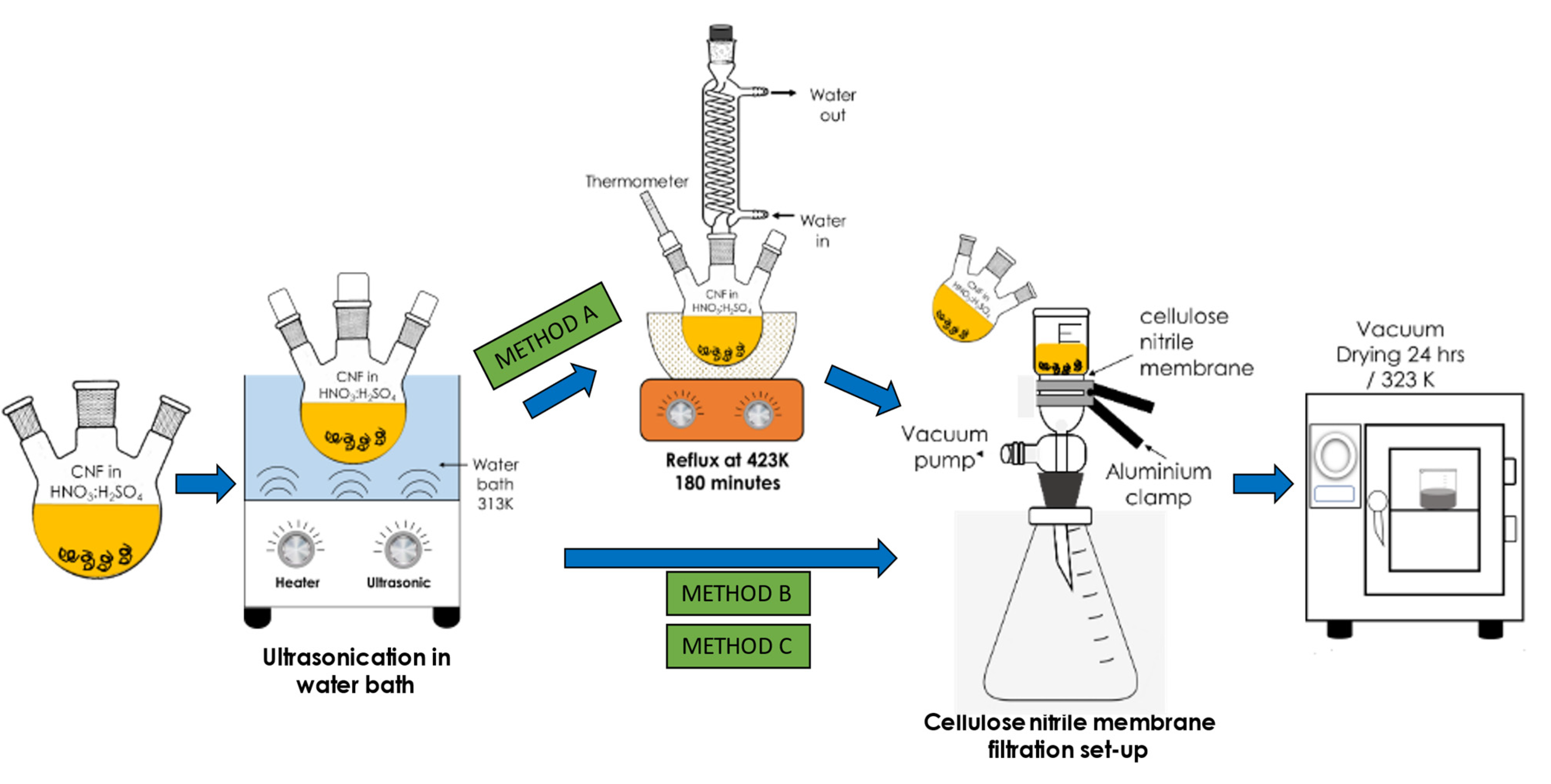
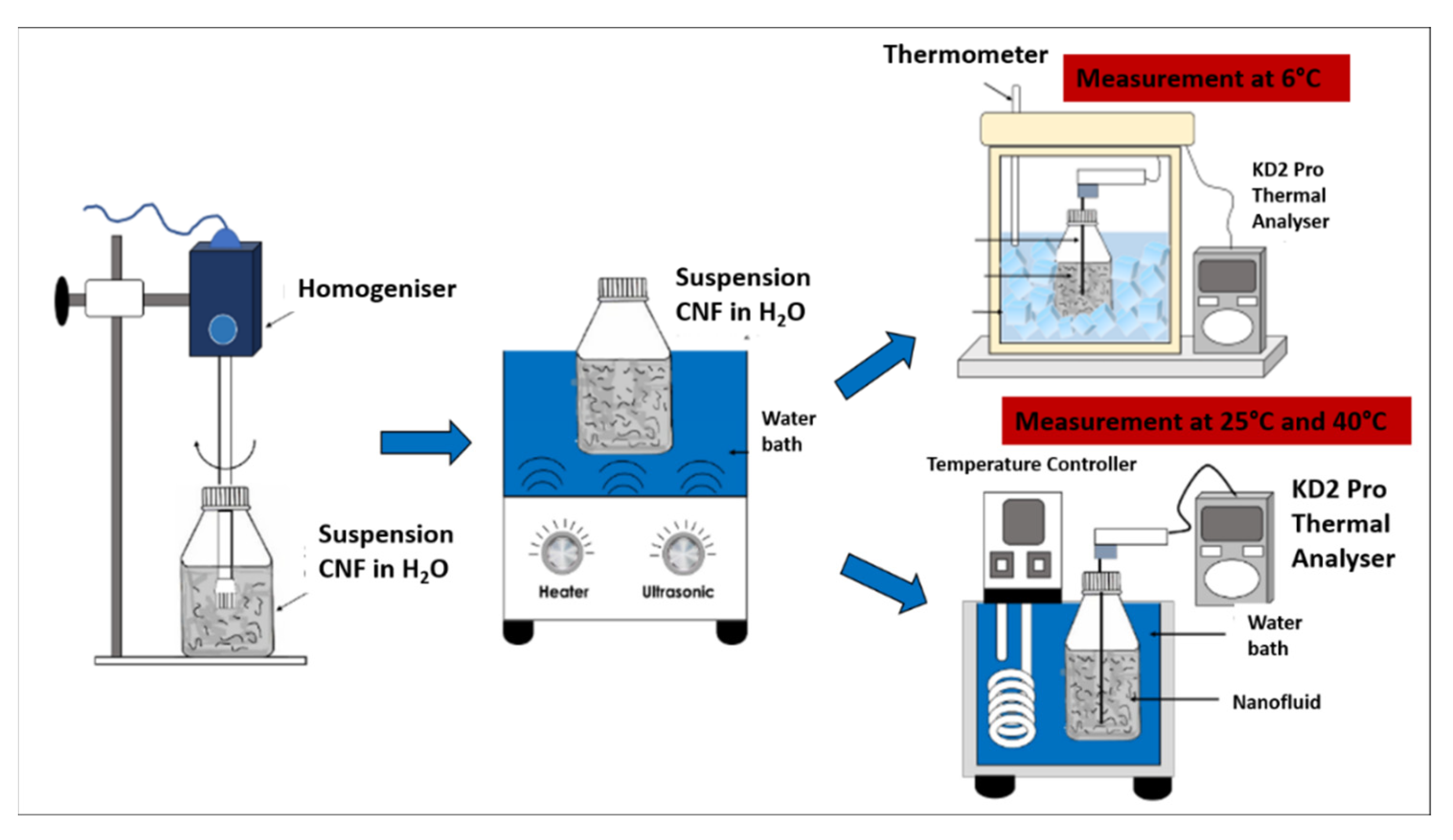
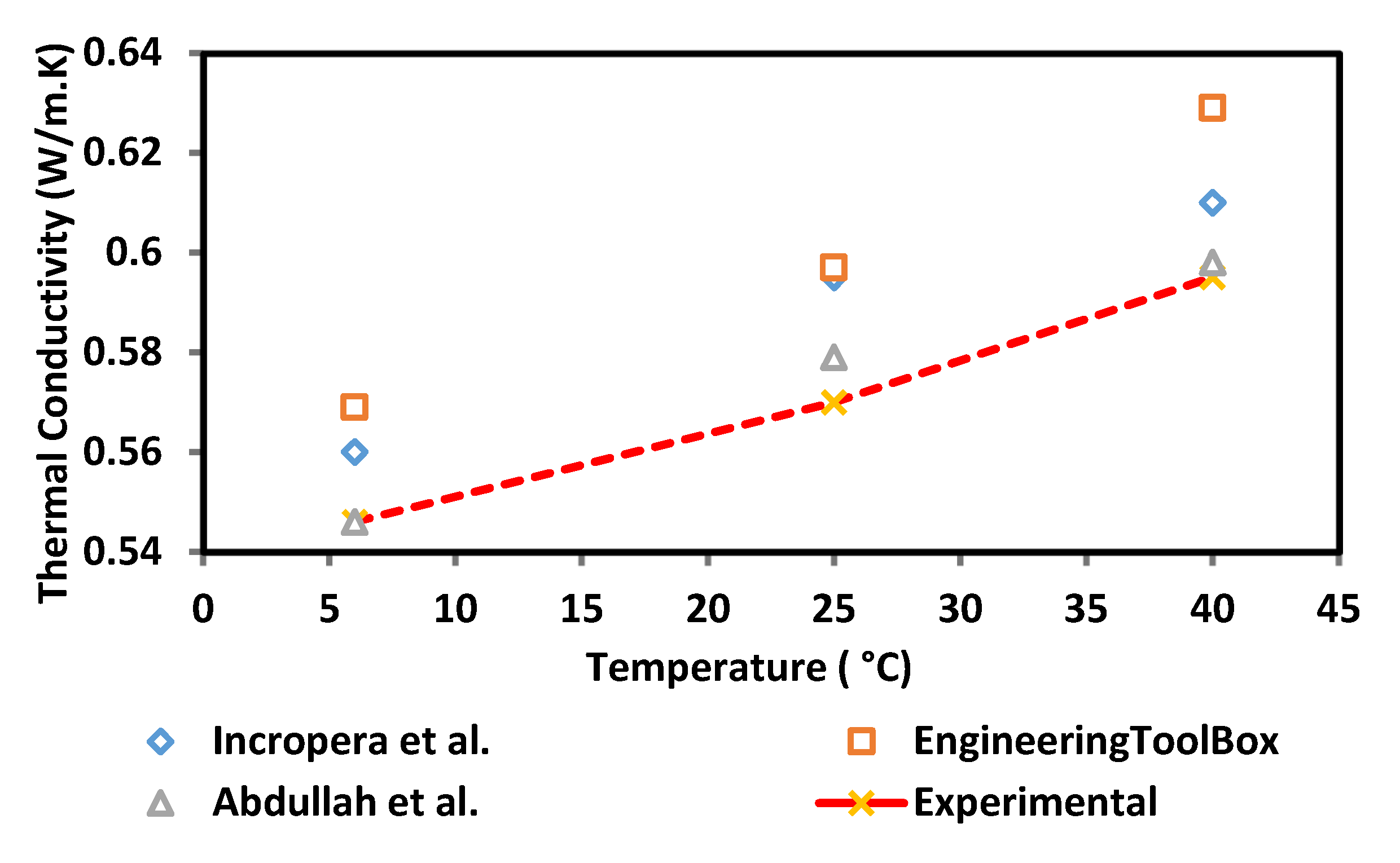
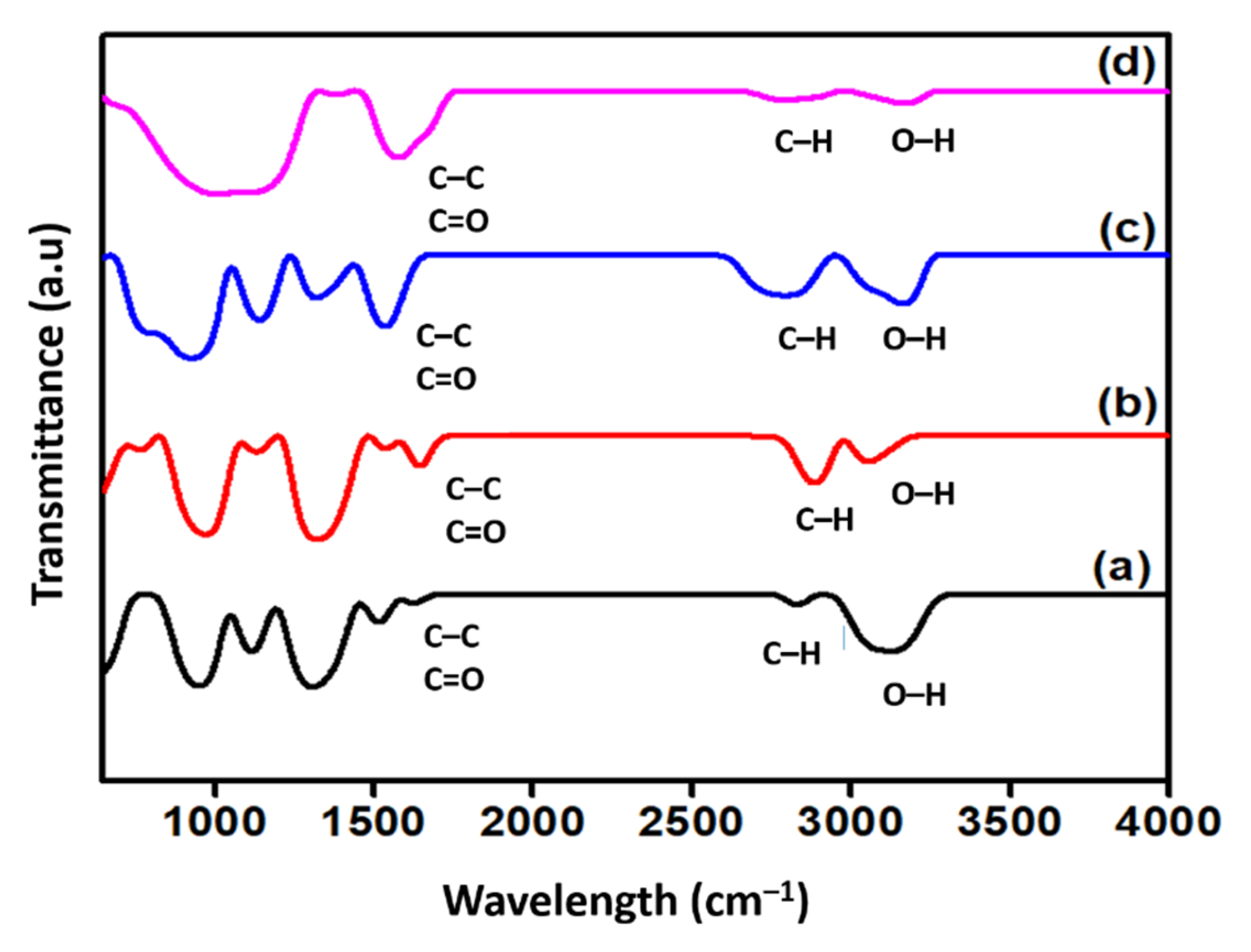
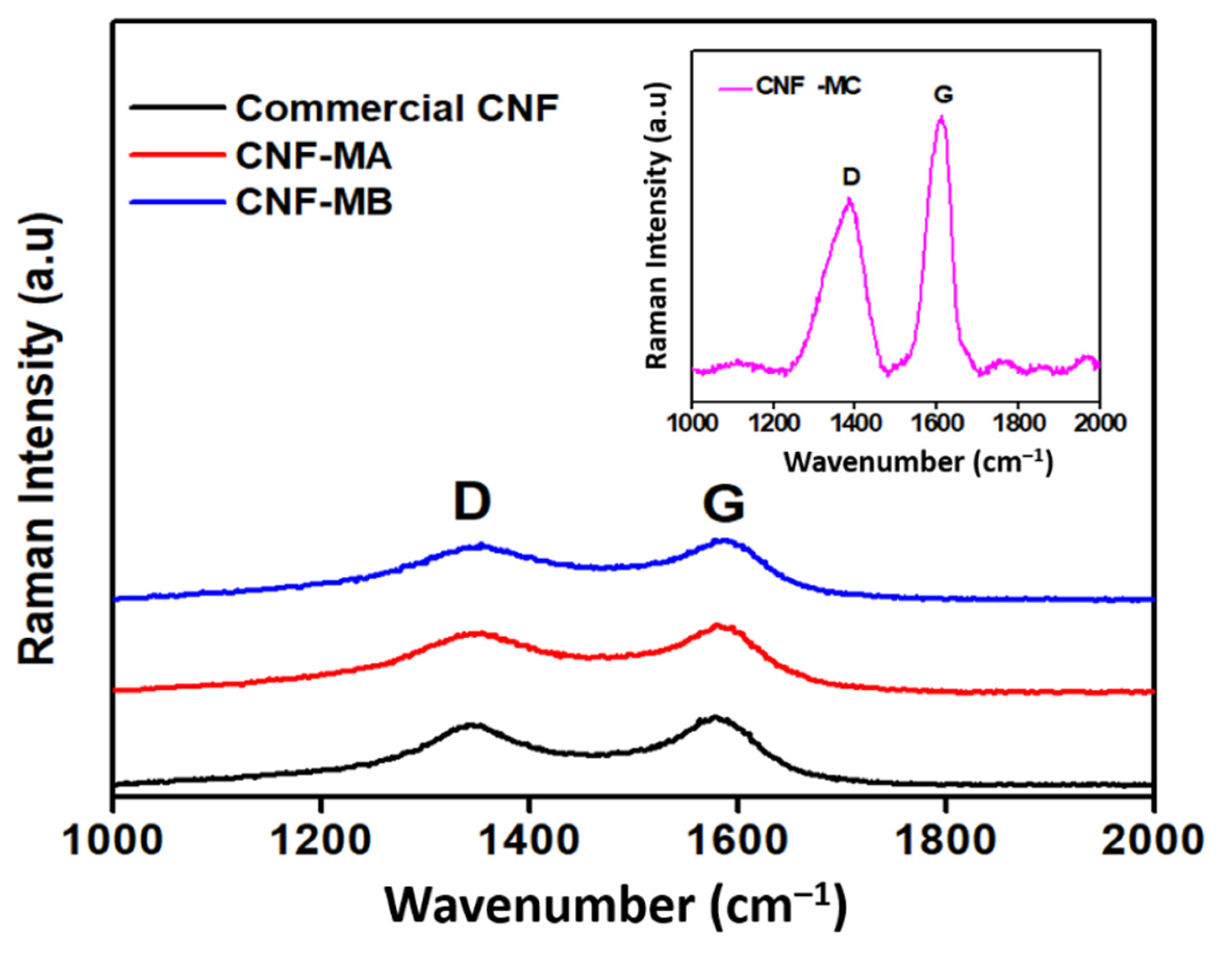

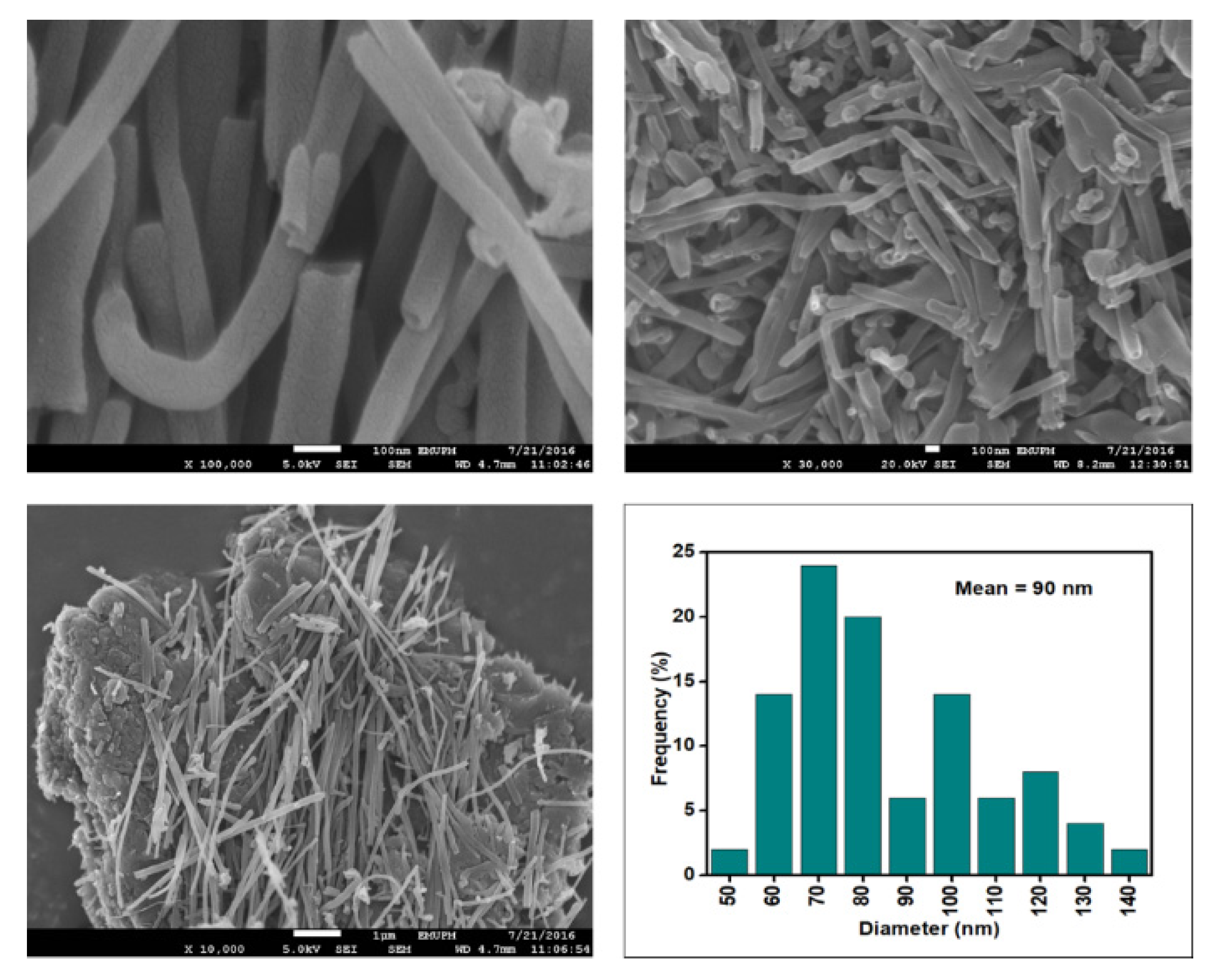

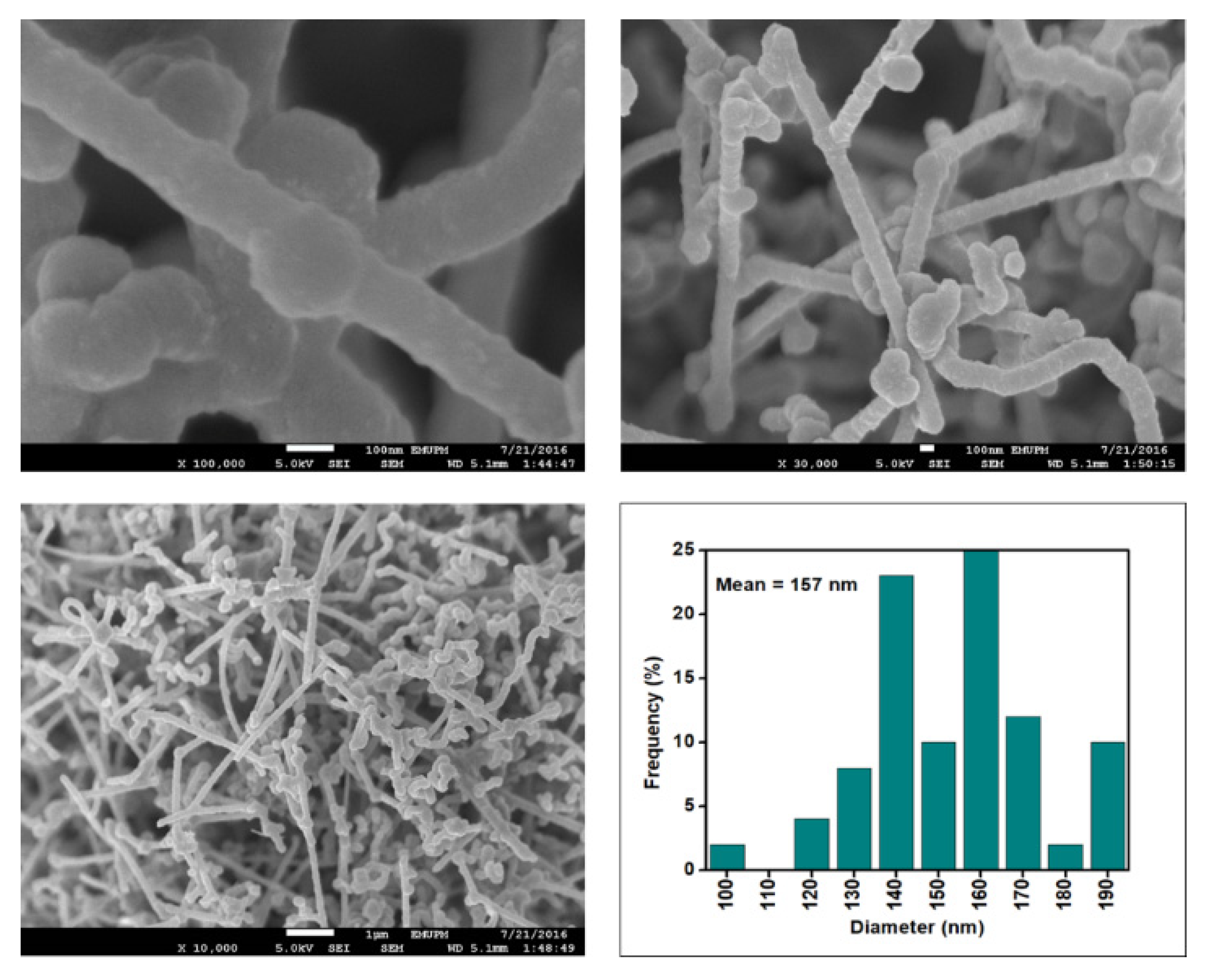
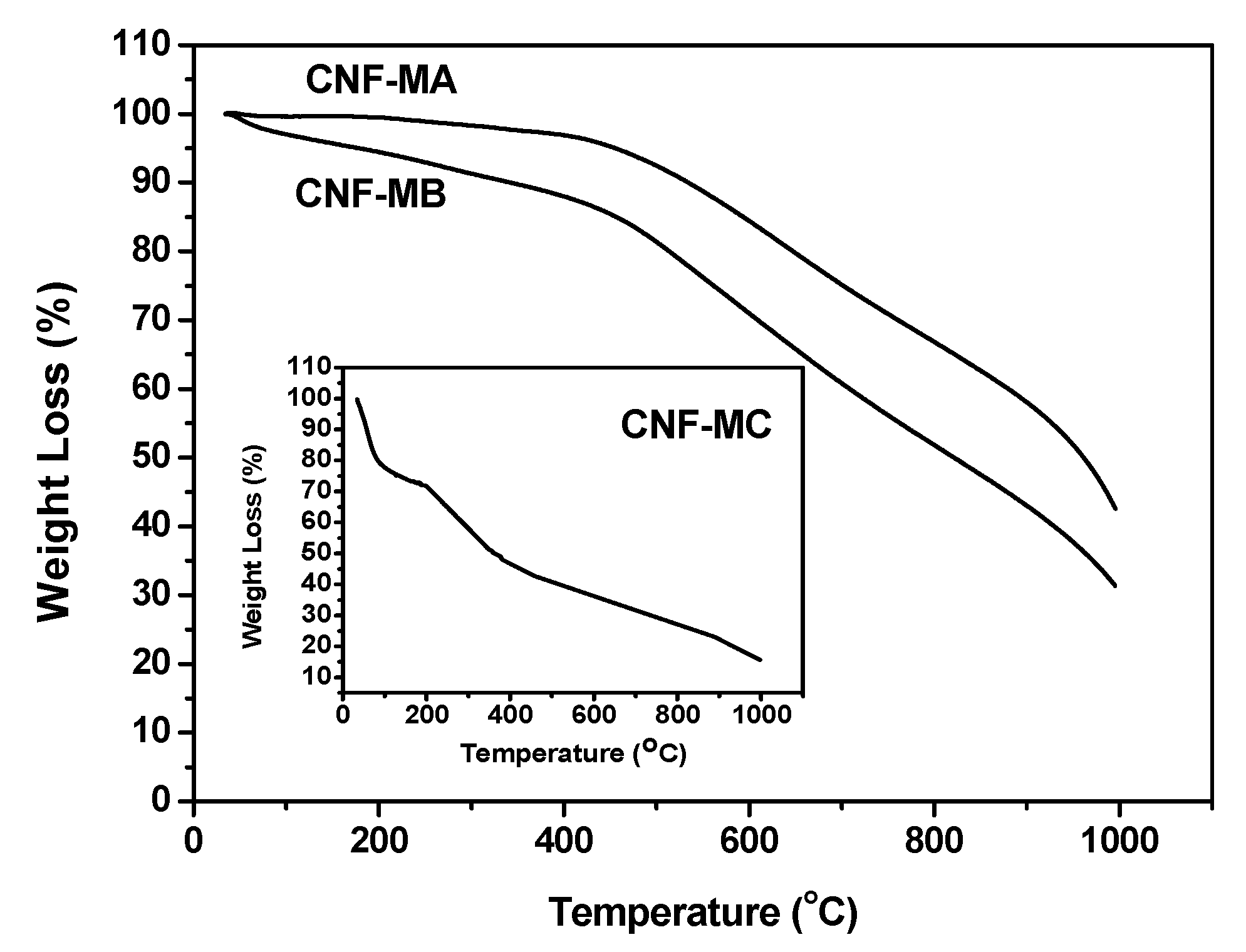
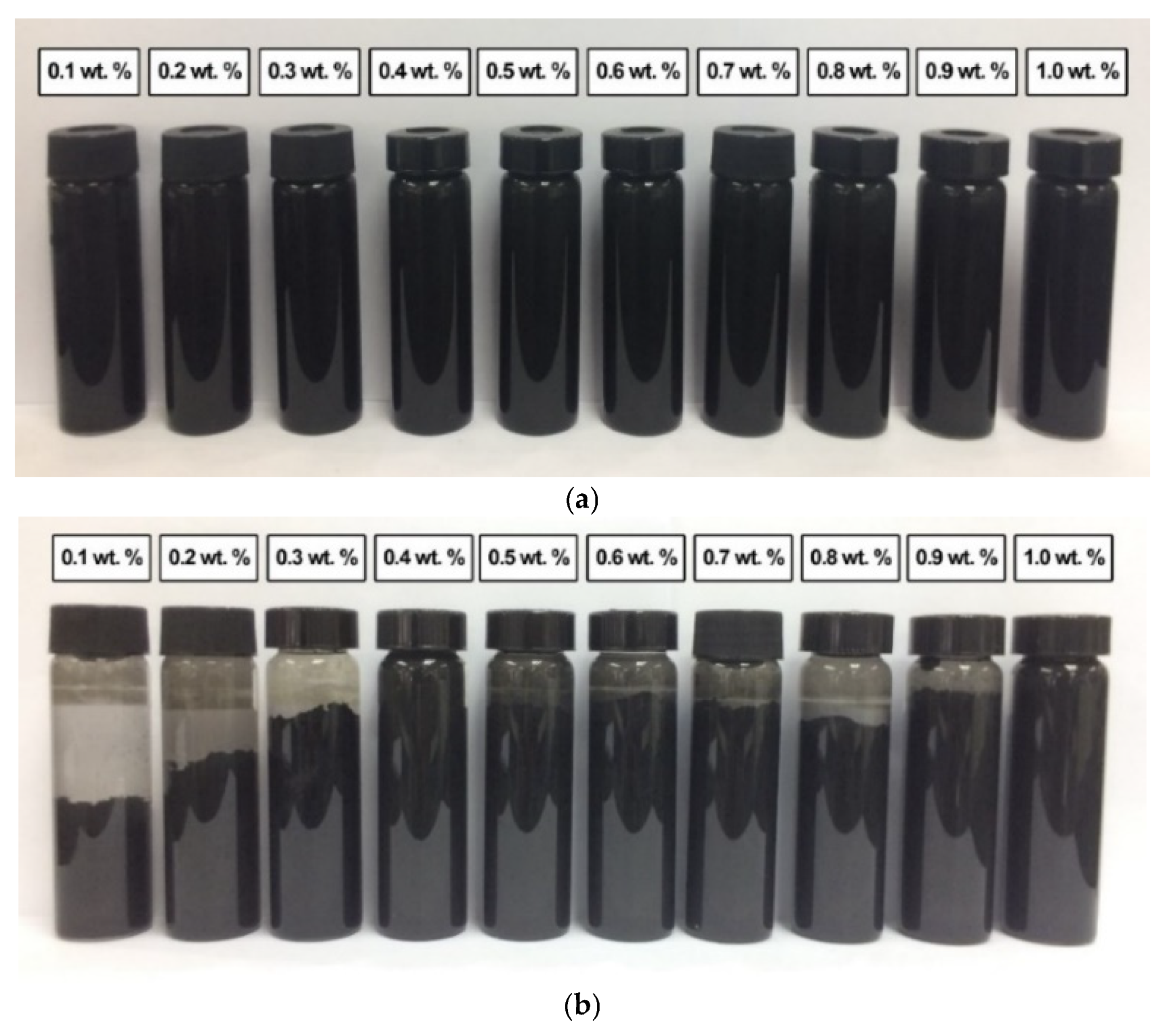


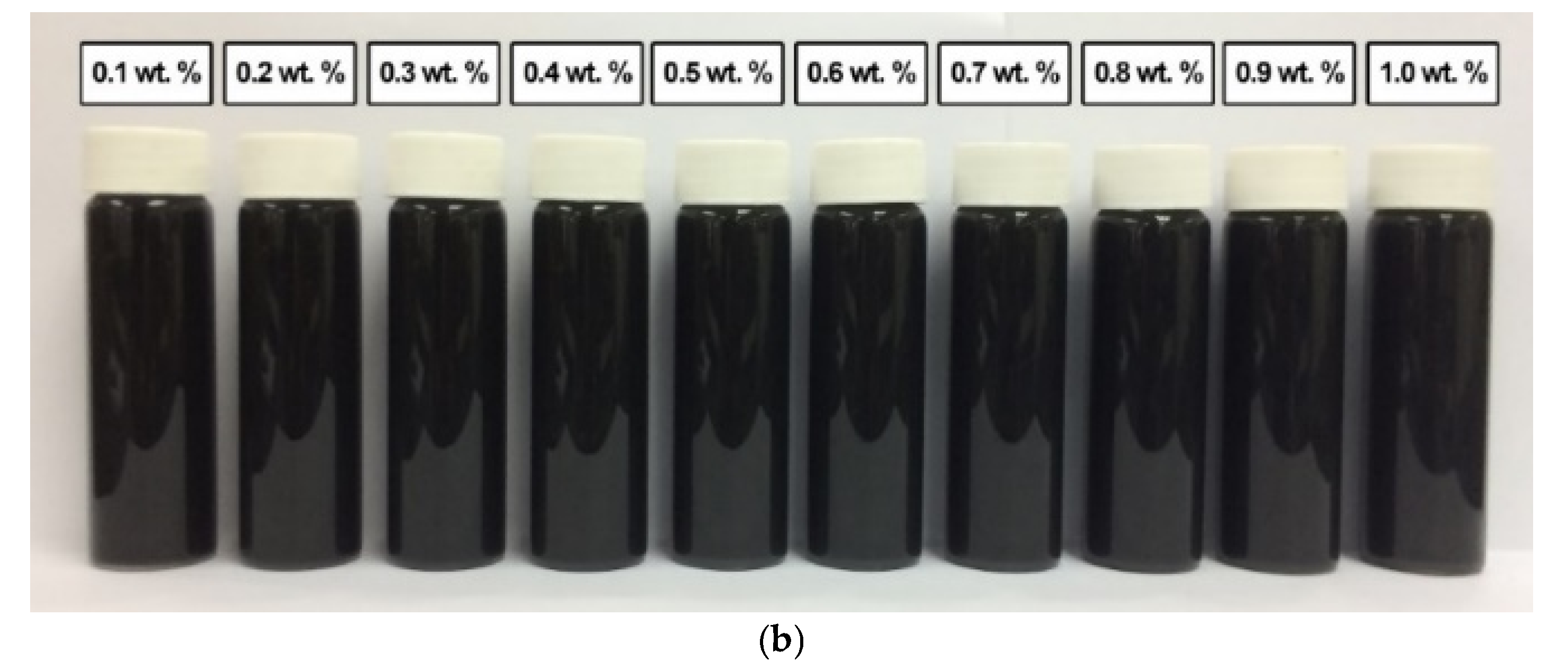
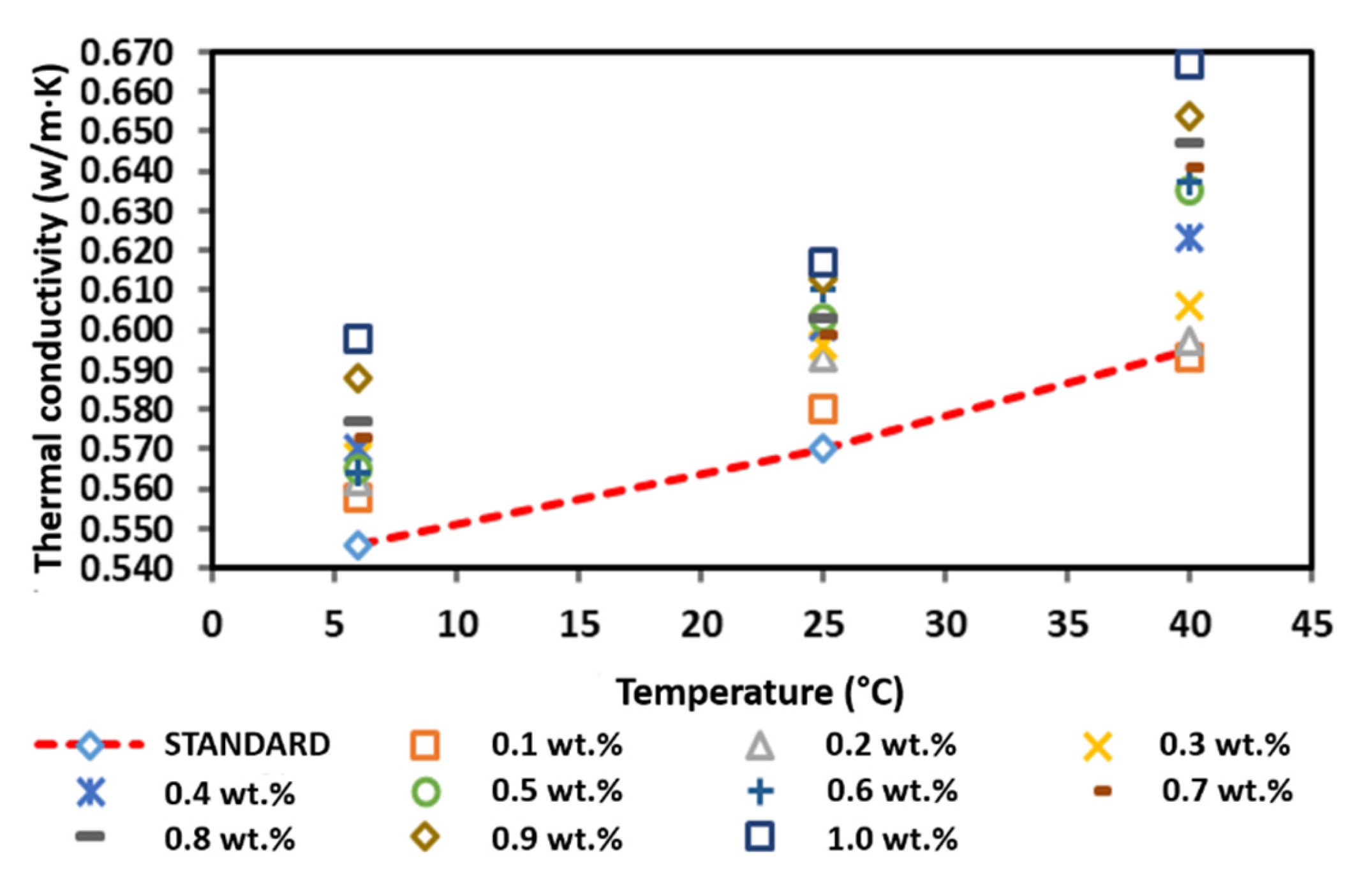


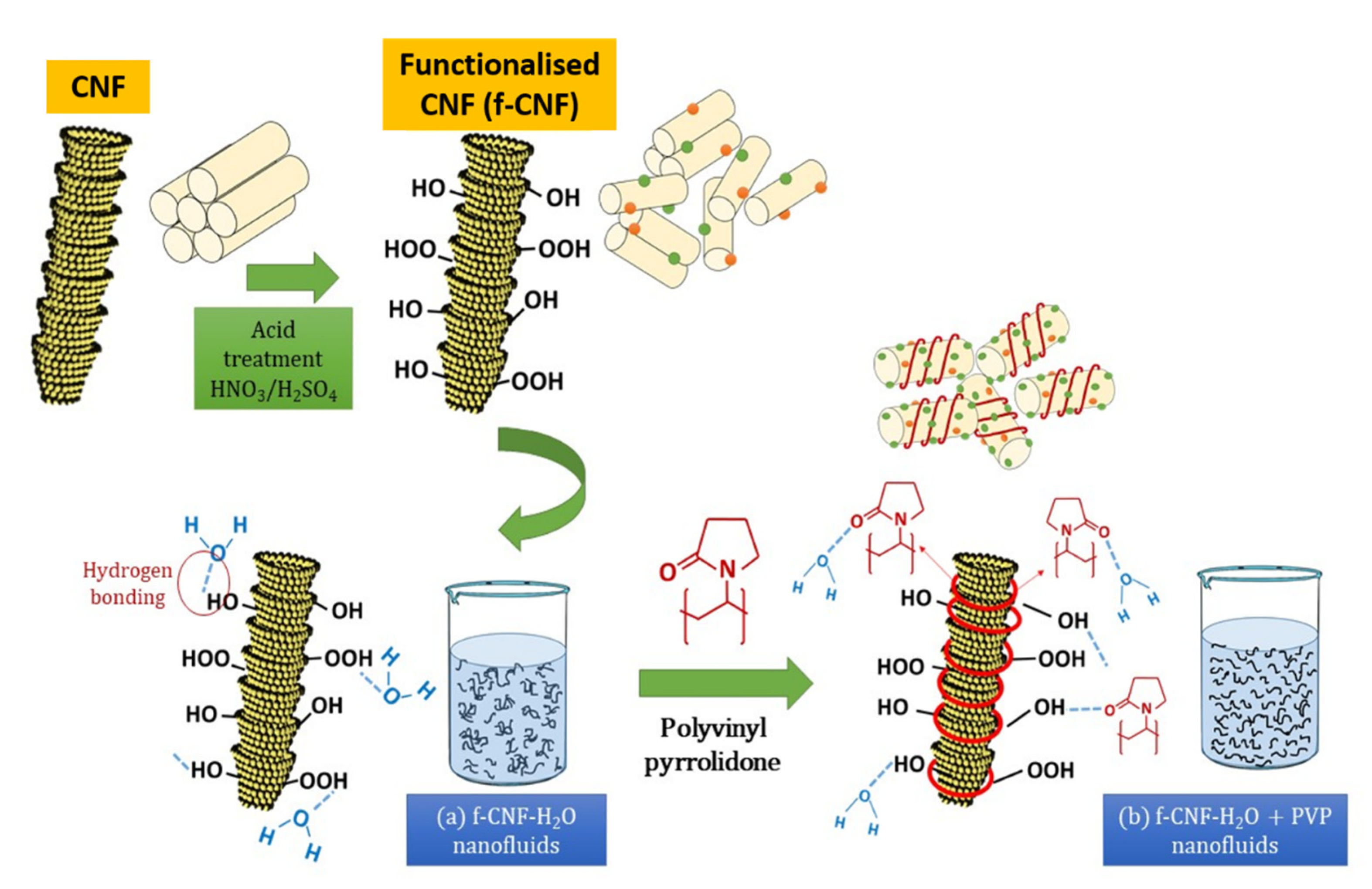
| Properties | Unit | Description |
|---|---|---|
| Fibre diameter | nm | 100 |
| Iron content | ppm | <100 |
| Polycyclic aromatic hydrocarbons (PAH content) | mg PAH/g fibre | <1 |
| Density | g/cm3 | 2.0 |
| Specific surface area | m2/g | 41 |
| Properties | Unit | Description | |
|---|---|---|---|
| H2SO4 | HNO3 | ||
| pH | - | 0.3 | <1 |
| Density | g/cm3 | 1.84 | 1.37 |
| Melting point | °C | −20 | 22 |
| Unit | Description | |
|---|---|---|
| Chemical formula | - | (C6H9NO)n |
| Physical state | - | Crystal powder |
| Colour | - | White to off-white |
| Density | g/cm3 | 1.6 |
| Sample | ID/IG Ratio |
|---|---|
| Commercial CNF | 0.74 |
| CNF-MA | 0.81 |
| CNF-MB | 0.88 |
| CNF-MC | 1.06 |
| Sample | Elemental Composition (wt.%) | |||
|---|---|---|---|---|
| C | O | Al | S | |
| Commercial-CNF | 92.42 | 7.44 | 0.15 | - |
| CNF-MA | 92.52 | 8.29 | 0.19 | - |
| CNF-MB | 92.95 | 9.69 | 0.17 | 0.16 |
| CNF-MC | 79.91 | 19.52 | 0.11 | 0.44 |
| Weight Concentration of Commercial CNFs (wt.%) | Percentage of Enhancement (%) | ||
|---|---|---|---|
| 6 °C | 25 °C | 40 °C | |
| 0.1 | 2.20 (0.005) | 1.75 (0.005) | - |
| 0.2 | 2.93 (0.002) | 4.04 (0.004) | 0.3 (0.005) |
| 0.3 | 4.03 (0.003) | 4.56 (0.005) | 1.8 (0.004) |
| 0.4 | 4.40 (0.005) | 5.44 (0.005) | 4.7 (0.005) |
| 0.5 | 3.48 (0.006) | 5.79 (0.004) | 6.7 (0.003) |
| 0.6 | 3.30 (0.007) | 7.02 (0.006) | 7.1 (0.005) |
| 0.7 | 4.95 (0.008) | 5.09 (0.005) | 7.7 (0.01) |
| 0.8 | 5.68 (0.005) | 5.79 (0.006) | 8.7 (0.006) |
| 0.9 | 7.69 (0.012) | 7.54 (0.009) | 9.9 (0.01) |
| 1.0 | 9.52 (0.015) | 8.25 (0.01) | 12.1 (0.01) |
| Weight Concentration of Surface-Oxidised CNFs (wt.%) | Percentage of Enhancement (%) | ||
|---|---|---|---|
| 6 °C | 25 °C | 40 °C | |
| 0.1 | 11.36 (0.002) | 9.16 (0.003) | 4.87 (0.001) |
| 0.2 | 11.90 (0.030) | 8.95 (0.003) | 6.22 (0.003) |
| 0.3 | 12.33 (0.005) | 10.00 (0.005) | 7.56 (0.004) |
| 0.4 | 11.72 (0.003) | 8.77 (0.003) | 8.57 (0.005) |
| 0.5 | 12.82 (0.004) | 10.18 (0.006) | 9.16 (0.005) |
| 0.6 | 12.45 (0.005) | 10.35 (0.007) | 9.58 (0.003) |
| 0.7 | 12.09 (0.007) | 10.70 (0.006) | 9.92 (0.004) |
| 0.8 | 13.37 (0.006) | 11.14 (0.009) | 11.22 (0.006) |
| 0.9 | 14.19 (0.008) | 11.33 (0.008) | 13.11 (0.010) |
| 1.0 | 14.34 (0.01) | 11.84 (0.009) | 16.13 (0.01) |
| Weight Concentration of Surface-Oxidised CNFs (wt.%) | Weight Concentration of PVP (wt.%) | Percentage of Enhancement (%) | ||
|---|---|---|---|---|
| 6 °C | 25 °C | 40 °C | ||
| 0.1 | 0.01 | 14.84 (0.001) | 11.19 (0.002) | 9.75 (0.01) |
| 0.2 | 0.02 | 15.20 (0.001) | 12.54 (0.003) | 10.76 (0.002) |
| 0.3 | 0.03 | 15.93 (0.003) | 13.46 (0.002) | 12.10 (0.003) |
| 0.4 | 0.04 | 16.12 (0.003) | 13.77 (0.003) | 13.92 (0.003) |
| 0.5 | 0.05 | 17.03 (0.003) | 14.82 (0.006) | 14.29 (0.004) |
| 0.6 | 0.06 | 17.44 (0.005) | 15.53 (0.005) | 16.97 (0.005) |
| 0.7 | 0.07 | 17.58 (0.005) | 16.84 (0.006) | 19.83 (0.006) |
| 0.8 | 0.08 | 18.13 (0.006) | 14.47 (0.007) | 15.63 (0.006) |
| 0.9 | 0.09 | 18.50 (0.008) | 13.68 (0.006) | 15.16 (0.007) |
| 1.0 | 0.10 | 17.86 (0.008) | 12.63 (0.008) | 11.76 (0.007) |
| Sample | Thermal Conductivity (W/m·K) | Remark | Ref. | |||
|---|---|---|---|---|---|---|
| 6 °C | 25 °C | 40 °C | Nanofluid Condition | Stability and Surface Area | ||
| Surface-oxidised CNF/ultra-pure water | 0.644 (0.005) | 0.666 (0.005) | 0.713 (0.006) | 0.7 wt.% of CNF, with 10wt.% of surfactant | No sedimentation and agglomeration up to 100 h after addition of PVP as surfactant | This study |
| Surface-oxidised CNF/ultra-pure water | 0.624 (0.01) | 0.638 (0.009) | 0.691 (0.01) | 1.0 wt.% of CNF without surfactant | ||
| CNF/ultra-pure water | 0.598 (0.015) | 0.667 (0.01) | 0.617 (0.01) | 1.0 wt.% of CNF without surfactant and without surface treatment | ||
| CNF/Deionised water:Ethylene glycol | 0.626 | 0.635 | 0.642 | −0.5 wt.% of CNF in base fluid composed of DI and EG (90:10), with 10% surfactant | - | [37] |
| Deionised water | 0.546 | 0.570 | 0.595 | - | ||
| Standard deionised water/Ethylene glycol | 0.544 | 0.551 | 0.566 | - | ||
| Ethylene glycol | 0.219 | 0.223 | 0.235 | - | - Zeta potential values of f-CNT nanofluids possess the highest value of 43.5 mV than the Cu/CNT and Ag/CNT nanofluids. - Cu/CNT and Ag/CNT hybrid nanofluids have been proven to have an excellent stability up to 6 months. | |
| CNT/Cu/Water | - | 0.65 (25 °C) | 0.80 (45 °C) | 0.05 wt.% of CNT, without surfactant | [38] | |
| CNT/Ag/Water | - | 0.67 (25 °C) | 0.81 (45 °C) | |||
| CNT/Cu/ Ethylene glycol | - | 0.270 (25 °C) | 0.285 (45 °C) | |||
| CNT/Ag/ Ethylene glycol | - | 0.272 (25 °C) | 0.288 (45 °C) | |||
| MWCNT/ ultra-pure water | 0.587 | 0.593 | 0.626 | 0.7 wt.% of MWCNT, without surfactant | - The result of stability of commercial MWCNTs based nanofluid with PVP is better compared to without PVP. - Addition of PVP improved the stability of nanofluids and prevented their settlement in water without undergoing acid treatment. - After acid treatment, the surface oxidised MWCNT-based nanofluid with PVP showed better stability. | [39] |
| MWCNT/ ultra-pure water | 0.608 | 0.628 | 0.650 | 0.9 wt.% of MWCNT, with surfactant | ||
| Surface-oxidised MWCNT/ ultra-pure water | 0.619 | 0.640 | 0.657 | 0.7 wt.% of MWCNT, without surfactant | ||
| Surface-oxidised MWCNT/ultra-pure water | 0.647 | 0.675 | 0.693 | 0.5 wt.% of MWCNT, with surfactant | ||
| SiO2/water | 0.620 | 0.72 (50 °C) | 1.0 vol.% of SiO2 and for hybrid is 70% SiO2 and graphene is 30% | - Zeta potential for hybrid nanofluids is 45 mV. - The presence of an isoelectric point in low-pH (3 and 6) values is more likely caused low stability. When pH is higher values (9 and 12), repulsive forces among dispersed nanoparticles are increased and the stability is improved. - Addition of carboxyl methyl cellulose (CMC) as surfactnt imporved the stability and thermal conductivity. | ||
| Graphene/SiO2/water | 1.24 | 1.36 | [40] | |||
| Graphene/water | - | 0.740 | - | 0.5%, without surfactant | - Measured zeta potential of the nanofluid with volume fraction of 0.005% was −47.6 mV which shows high stability of the nanofluid. - Addition of TiO2 in graphene/water nanofulids had improved the stability of nanofluids | [41] |
| TiO2/graphene/water | - | 0.720 | 0.790 (45 °C) | |||
| TiO2 | - | 0.700 | - | |||
| Al2O3/SiO2/water | - | 0.700 | 0.750 | 0.5% Al2O3 + 2.5% SiO2 | - | [42] |
Publisher’s Note: MDPI stays neutral with regard to jurisdictional claims in published maps and institutional affiliations. |
© 2022 by the authors. Licensee MDPI, Basel, Switzerland. This article is an open access article distributed under the terms and conditions of the Creative Commons Attribution (CC BY) license (https://creativecommons.org/licenses/by/4.0/).
Share and Cite
Mohd Saidi, N.; Abdullah, N.; Norizan, M.N.; Janudin, N.; Mohd Kasim, N.A.; Osman, M.J.; Mohamad, I.S.; Mohd Rosli, M.A. Surface-Oxidised Carbon Nanofibre-Based Nanofluids: Structural, Morphological, Stability and Thermal Properties. Nanomaterials 2022, 12, 3922. https://doi.org/10.3390/nano12213922
Mohd Saidi N, Abdullah N, Norizan MN, Janudin N, Mohd Kasim NA, Osman MJ, Mohamad IS, Mohd Rosli MA. Surface-Oxidised Carbon Nanofibre-Based Nanofluids: Structural, Morphological, Stability and Thermal Properties. Nanomaterials. 2022; 12(21):3922. https://doi.org/10.3390/nano12213922
Chicago/Turabian StyleMohd Saidi, Norshafiqah, Norli Abdullah, Mohd Nurazzi Norizan, Nurjahirah Janudin, Noor Azilah Mohd Kasim, Mohd Junaedy Osman, Imran Syakir Mohamad, and Mohd Afzanizam Mohd Rosli. 2022. "Surface-Oxidised Carbon Nanofibre-Based Nanofluids: Structural, Morphological, Stability and Thermal Properties" Nanomaterials 12, no. 21: 3922. https://doi.org/10.3390/nano12213922
APA StyleMohd Saidi, N., Abdullah, N., Norizan, M. N., Janudin, N., Mohd Kasim, N. A., Osman, M. J., Mohamad, I. S., & Mohd Rosli, M. A. (2022). Surface-Oxidised Carbon Nanofibre-Based Nanofluids: Structural, Morphological, Stability and Thermal Properties. Nanomaterials, 12(21), 3922. https://doi.org/10.3390/nano12213922






